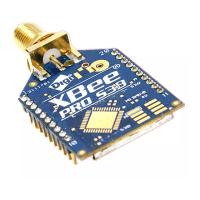Networking methods Delivery methods
XBee®-PRO 900HP/XSC RF Modules
69
P2MP throughput
The following table shows the throughput for the 10 kb/s version, using a 115.2 kb/s serial data rate.
Configuration Data throughput
Point to point unicast, encryption disabled 8.8 kb/s
Point to point unicast, encryption enabled 8.7 kb/s
The following table shows the throughput for the 200 kb/s version, using a 115.2 kb/s serial data rate.
Configuration Data throughput
Point to point unicast, encryption disabled 105.5 kb/s
Point to point unicast, encryption enabled 105.4 kb/s
Digi made data throughput measurements setting the serial interface rate to 115200 b/s, and
measuring the time to send 100,000 bytes from source to destination. During the test, no route
discoveries or failures occurred.
Repeater/directed broadcast
All of the routers in a network receive and repeat directed broadcast transmissions. Because it does
not use ACKs, the originating node sends the broadcast multiple times. By default a broadcast
transmission is sent four times—the extra transmissions become automatic retries without
acknowledgments. This results in all nodes repeating the transmission four times. Sending frequent
broadcast transmissions can quickly reduce the available network bandwidth, so use broadcast
transmissions sparingly.
MAC layer
The MAC layer is the building block that is used to build repeater capability. To implement Repeater
mode, we use a network layer header that comes after the MAC layer header in each packet. In this
network layer there is additional packet tracking to eliminate duplicate broadcasts.
In this delivery method, the device sends both unicast and broadcast packets out as broadcasts that
are always repeated. All repeated packets are sent to every device. The devices that receive the
broadcast send broadcast data out their serial port.
When a device sends a unicast, it specifies a destination address in the network header. Then, only the
device that has the matching destination address sends the unicast out its serial port. This is called a
directed broadcast.
Any node that has a CE parameter set to router rebroadcasts the packet if its BH (broadcast hops) or
broadcast radius values are not depleted. If a node has already seen a repeated broadcast, it ignores
the broadcast.
The NH parameter sets the maximum number of hops that a broadcast transmission is repeated. The
device always uses the NH value unless you specify a BH value that is smaller.
By default the CE parameter is set to route all broadcasts. As such, all nodes that receive a repeated
packet will repeat it. If you change the CE parameter, you can limit which nodes repeat packets, which
helps dense networks from becoming overly congested while packets are being repeated.
Transmission timeout calculations for Repeater/directed broadcast mode are the same as for
DigiMesh broadcast transmissions.

